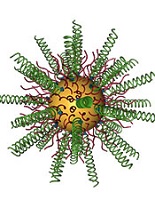 |
| Gold nanoparticle with spherical nucleic acids on the surface--Courtesy of Northwestern University |
To deliver a genetic kill switch to a particularly aggressive brain tumor, researchers at Northwestern University are turning to gold nanoparticles designed to maneuver their way into the cancer cells.
The team has developed a technique to deliver RNA-based drugs to glioblastoma multiforme, a highly aggressive and difficult-to-treat brain tumor that is currently considered incurable. The Northwestern researchers are the first to show that this delivery is possible, according to a report from the university.
The genetic component of the drug is a slightly different type of interfering RNA called spherical nucleic acids (SNA), invented at Northwestern in 1996, that are nontoxic to humans, as opposed to many other cancer treatments. The SNA knocks down the gene Bcl2Like12, which is abundant in glioblastoma tumors and often allows for its resistance to drugs.
And the delivery method is unique: The nanoparticle has a spherical shape that allows it to maneuver into the cancer cells. And by densely packing the nucleic acids onto the gold's surface, the genetic material can enter the cell by hitching a ride with the delivery vehicle. The team published the study in the journal Science Translational Medicine.
"This is a beautiful marriage of a new technology with the genes of a terrible disease," said Northwestern study author Chad Mirkin. "Using highly adaptable spherical nucleic acids, we specifically targeted a gene associated with GBM and turned it off in vivo. This proof-of-concept further establishes a broad platform for treating a wide range of diseases, from lung and colon cancers to rheumatoid arthritis and psoriasis."
And as for the ambitious project that brought several labs together to develop the technology, Mirkin added: "The problems posed by glioblastoma and many other diseases are simply too big for one research group to handle. This work highlights the power of scientists and engineers from different fields coming together to address a difficult medical issue."
The team next plans to bring the technique into clinical trials.
- here's the Northwestern University report